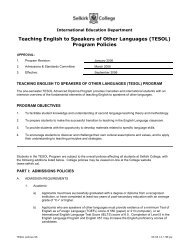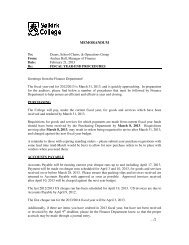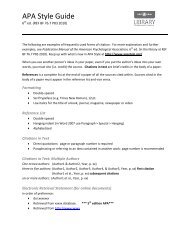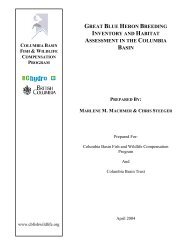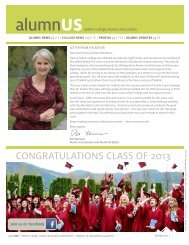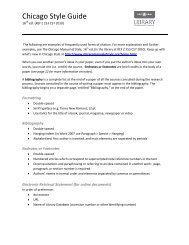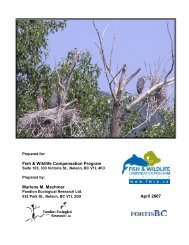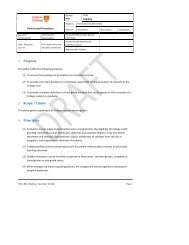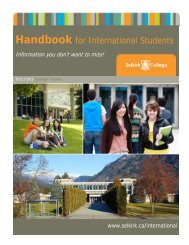selk irk.ca - Selkirk College
selk irk.ca - Selkirk College
selk irk.ca - Selkirk College
Create successful ePaper yourself
Turn your PDF publications into a flip-book with our unique Google optimized e-Paper software.
Geographic Information Systems<br />
done so at Selk<strong>irk</strong> <strong>College</strong>. International students<br />
will be expected to provide a TOEFL<br />
exam score of 550 or above unless they<br />
have equivalent documentation of English<br />
proficiency. (A “B” or above in English 12 or<br />
an LPI score of 4 or above would be examples<br />
of such equivalency.)<br />
• Appli<strong>ca</strong>nts may be required to complete<br />
modules in mathematics, writing and<br />
computer technology skills if knowledge gaps<br />
in one or more of these areas are identified by<br />
the School Chair.<br />
General<br />
• Personal Reference. All appli<strong>ca</strong>nts must<br />
submit two personal references on the form<br />
provided in the appli<strong>ca</strong>tion package.<br />
• Letter of Intent.All appli<strong>ca</strong>nts must complete<br />
a brief essay of 500 words or less that states<br />
their background and personal interest in<br />
the Advanced Diploma in GIS. Appli<strong>ca</strong>nts<br />
should highlight experience in GIS and<br />
computer skills in their essay.<br />
• Specific Requirements for Students Without<br />
A Formal Credential from an Accredited<br />
Post-Secondary Institution<br />
• An appli<strong>ca</strong>nt with reasonable potential for<br />
success on the basis of work experience or<br />
other criteria may be admitted, notwithstanding<br />
some deficiency in prior formal<br />
edu<strong>ca</strong>tion.<br />
• Appli<strong>ca</strong>nts with no accredited post‚ s<br />
secondary credential may require a<strong>ca</strong>demic<br />
upgrading. They are urged to apply for the<br />
program at least one year in advance.<br />
Appli<strong>ca</strong>tion Procedure<br />
• Before an appli<strong>ca</strong>nt’s file is considered<br />
complete, the following must be received by<br />
the Admissions Office:<br />
• Completed appli<strong>ca</strong>tion form,<br />
• Official transcripts of all relevant postsecondary<br />
edu<strong>ca</strong>tion,<br />
• Official transcripts of high school grades will<br />
be required for appli<strong>ca</strong>nts entering without a<br />
credential from an accredited post-secondary<br />
institution,<br />
• Two personal reference forms completed by a<br />
current or previous instructor, counsellor or<br />
employer, e.g., supervisor. Personal references<br />
should be submitted by the referee directly to<br />
the Admissions Office. (Photocopies are not<br />
acceptable),<br />
• Completed letter of intent.<br />
Program Courses<br />
GIS 302 Introduction to GIS<br />
This course is an introduction to GIS theory,<br />
history and appli<strong>ca</strong>tion. Emphasis will be placed<br />
on understanding how geospatial features are<br />
represented and <strong>ca</strong>ptured as data and how these<br />
data <strong>ca</strong>n be managed, analyzed and presented using<br />
state-of-the-art GIS tools. Hands-on expertise will<br />
be developed with ESRI’s ArcGIS software.<br />
GIS 303 GIS Analysis and Automation<br />
This course will build upon the fundamentals of<br />
GIS theory by examining geodata models, data<br />
management and metadata, <strong>ca</strong>rtography, advanced<br />
analysis, 3D modeling, batching and scripting,<br />
and accessing, importing, and translating data.<br />
The lab portion of this course will focus on the<br />
use of Python scripting for automating ArcGIS<br />
and its extensions.<br />
GIS 306 Introduction to<br />
Remote Sensing<br />
This course will integrate both lecture and lab<br />
time to cover the foundations of remote sensing<br />
and engage in specific appli<strong>ca</strong>tions such as image<br />
classifi<strong>ca</strong>tion and multi-spectral analysis.<br />
GIS 310 GIS Data Management<br />
This course is an introduction to the fundamentals<br />
of spatial data and data management principles.<br />
With a focus on data specifi<strong>ca</strong>lly in BC and in<br />
relation to federal, provincial, municipal, regional<br />
and industry, students will learn about the variety<br />
and types of data and datasets commonly used.<br />
Topics include the ethics of data use, access to BC<br />
data, data translation and management tools and<br />
data management principles.<br />
GIS 316 Introduction to CAD<br />
for GIS Professionals<br />
This course provides an introduction to Autodesk’s<br />
computer-assisted design and drafting software for<br />
GIS students. Students will learn the fundamentals<br />
of the drafting environment, including setting<br />
up their workspace, utilizing common tools,<br />
creating and modifying drawings, and crafting<br />
print layouts.<br />
This course will frequently touch upon the<br />
differences and similarities of CAD and GIS as<br />
well as when and how GIS professionals will use<br />
CAD in their <strong>ca</strong>reer and how transitions between<br />
the two environments may occur. GIS students<br />
should gain appreciation of the complementary<br />
technology that CAD offers.<br />
GIS 318 Cartography and<br />
Geovisualization<br />
Cartography is the art and science of map making<br />
and map use. Preparation of high quality maps<br />
that readily reveal land management, planning,<br />
environmental or other concerns is criti<strong>ca</strong>l to<br />
ensure that important messages are conveyed in an<br />
easily interpretable fashion. This course introduces<br />
the concepts and methods of <strong>ca</strong>rtographic<br />
communi<strong>ca</strong>tion, design, and geovisualization.<br />
Mapping fundamentals will address subjects<br />
such as coordinate systems, projections, datums,<br />
<strong>ca</strong>rtographic generalization, map types, and map<br />
design considerations. Virtual <strong>ca</strong>rtography and<br />
other topi<strong>ca</strong>l methods of conveying geoinformation,<br />
such as computer atlases, web mapping, and<br />
3D-4D visualization will also be explored.<br />
GIS 321 New Media for GIS<br />
A venue to show<strong>ca</strong>se your work or business is<br />
important, no matter what your profession.<br />
This New media course consists of a series of<br />
workshops designed to build skills using some<br />
popular New media industry tools, including<br />
Adobe Photoshop, Adobe Illustrator, CamStudio,<br />
and an Open Source CMS; Wordpress.<br />
In addition to creating New media products, we<br />
will also explore social media tools and their benefits.<br />
Learning these tools will provide you with a<br />
strong foundation from which you <strong>ca</strong>n build your<br />
own website, hosting your own interesting media<br />
outputs to show<strong>ca</strong>se your work.<br />
GIS 323 Introduction to Global<br />
Navigation Satellite Systems<br />
This course will introduce the fundamental concepts<br />
of Global Navigation Satellite Systems with<br />
specific emphasis on Global Positioning System<br />
(GPS) and the applied technologies for GPS data<br />
collection and GIS integration. Through interactive<br />
instruction and hands-on course exercises, students<br />
will work with a variety of GPS tools and field<br />
collection techniques to learn how to create, edit,<br />
update and manage geographic information.<br />
Emphasis areas will include familiarity with GPS<br />
receivers, GPS processing software, data collection<br />
standards and <strong>ca</strong>rtography.<br />
GIS 329 Principles of Programming<br />
Selk<strong>irk</strong> <strong>College</strong> offers GIS 329 Visual Basic<br />
Programming to students enrolled in the<br />
Advanced Diploma or Bachelor’s programs in<br />
Geographic Information Systems. GIS329 Visual<br />
Basic Programming introduces fundamentals in<br />
programming, user-interface design, and software<br />
development to novice programmers.<br />
GIS 307 Remote Sensing in<br />
Resource Management<br />
Building upon the skills introduced in Introduction<br />
to Remote Sensing I, this course will cover topics<br />
in the biophysi<strong>ca</strong>l, geophysi<strong>ca</strong>l, and human activity<br />
appli<strong>ca</strong>tions of remote sensing as well as change<br />
detection, object-oriented analysis, and active and<br />
passive imaging. Lectures will be integrated with<br />
labs emphasizing practi<strong>ca</strong>l experience in remote<br />
sensing software appli<strong>ca</strong>tions..<br />
This course consists, in part, of an independent<br />
project designed and conducted by groups of<br />
students to foster a team approach in executing a<br />
182 Selk<strong>irk</strong> <strong>College</strong> 12/13 School of Environment and Geomatics




